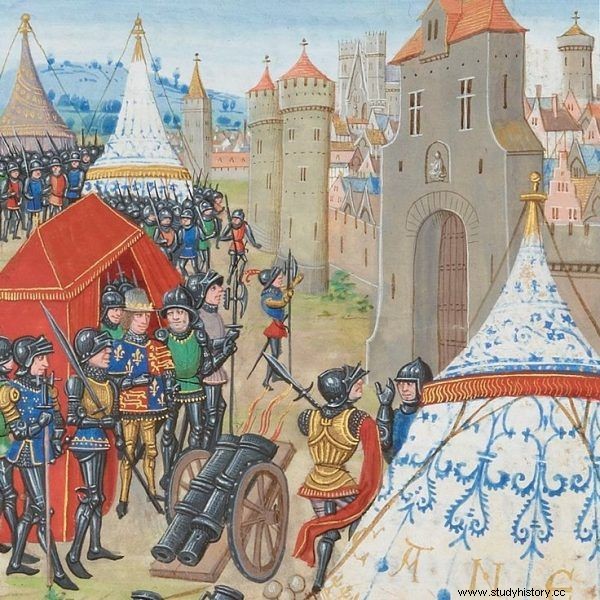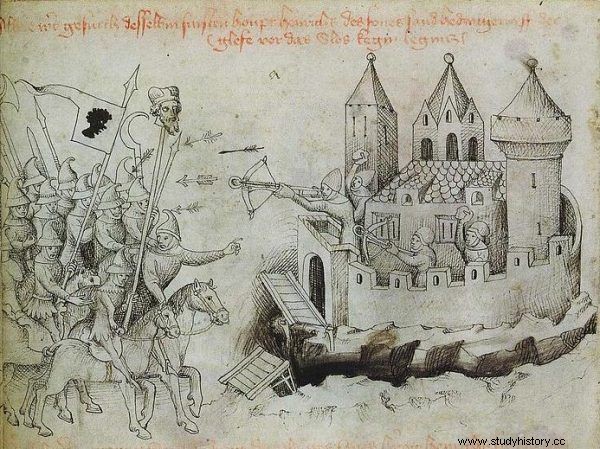Today, in the event of an armed conflict, fortified fortresses would not matter much. But when the horse was the best means of transport and explosives were virtually non-existent, locks were the most important strategic points ...
Medieval defenses were really hard to get. Historical data say that the cast on the walls could effectively resist up to ten times greater enemy forces. The builders paid special attention to securing key points, such as entrance gates - so that it would be impossible to cross them without a proper trick ...
So the question is, why actually attack the castle? After all, it would be enough to conquer the surrounding lands and wait for the people behind the walls to surrender. Well, it's not that simple…
Center point
First, the castle was politically important. Conquering a fortress that was impenetrable gave the attackers a moral advantage - if thick stone walls and a hail of missiles failed to stop them, what else could it do?
The location of the building was equally important. Castles were most often built in such a way as to prevent incoming troops from invading. They were a great starting point for mounted troops that could harass the enemy and then hide safely inside.

Castle Siege
So even if the surrounding buildings were captured, the attackers could not simply go further, leaving the stronghold alone: quick raids would undoubtedly destroy the supply lines, and thus starve the enemy soldiers.
Therefore, the troops besieging the castles faced a very difficult task. Strongholds were usually built on hills, near important trade points, at river confluences, seaports or mountain passes, i.e. in places that simply had to be conquered to win!
Immovable Object
The main means of defense of the castle was, of course, the wall (called the curtain wall), closing access to the buildings inside. There was a strip of bare ground in front of him, devoid of any potential cover for attackers to hide behind. And often also a moat - making access even more difficult.
If the aggressors decided to attack the gate frontally, they had to cross the barbican. The structure, which we know very well, for example from Krakow, was very difficult to overcome. It was equipped with arrowslits, grates and hot tar discharge stations.
Additional protection, hiding fragments of the wall, were towers, from which it was easy for shooters to fire at opponents at an angle. Therefore, it was not enough to cover yourself with a shield from the front - the missiles fell on the attacking soldiers from all sides.
We have plenty of food
Strange and unlikely as it seems, providing the castle crew with food was an easier task than feeding the besieging army. For example, Chepstow Fortress had storages with hens, pigs and cattle during the siege. Animals were brought there as soon as news of the impending attack reached the defenders.
Meanwhile, the attacking army could only rely on its own supplies and deserted areas, where it was difficult to get large amounts of food.
Locks often obtained supplies from "wholesale" suppliers. As long-haul transportation developed enough to make the heavy haulage profitable, fortress owners eagerly used this kind of service. The Rochester fortress therefore received shipments of herring, sheep, salted meat, figs, rice and raisins from individual merchants. or whole groups acting in the interests of common interest.
A trick for everything
Due to the difficulties in capturing castles, attackers very often resorted to alternative solutions. A popular way to deprive the defenders of the will to fight was to cut off access to the water. In this way, the Muslims won the siege of Xerigordo Castle, where Christians defended themselves. Those after eight days without fresh water - and after trying to drink urine and horse blood - were forced to give up.
A similar situation took place during the siege of Henry I Castle in Alençon, when Count Fulko's men destroyed the connection between the fortress and the river. It happened that the inhabitants of the stronghold tried to survive by drinking wine as well as using it for cooking - so did the crew in Exeter in 1136. As you can guess, they didn't take a long time like this…
A completely different type of trick was a surprise attack, often called escalade in French . It consisted of a small strike group climbing the wall to open the gate. This was obviously a very risky move as it had to take place at night.
Every weak point in the structure was exploited, including ... a latrine outlet, through which soldiers could also enter. A diversion was also used, consisting in drawing the defenders' attention away from one of the entrances, and then suddenly hitting this place.
In turn, a popular way to get rid of a fragment of the wall was to make a tunnel and then collapse the tunnel. In 1215 John without Earth besieged the stronghold in Rochester and used this very method: ordered to quickly produce as many pickaxes as possible and dig a tunnel under one of the towers. Then forty fat piglets were driven inside ("The kind of worse to eat" - as we learn from the description of the siege) and setting them on fire. The fat from the animals caught fire and reached such a temperature that the wooden supports fell apart, dragging a large part of the stone keep with it.

The siege of a medieval castle
Weapon ideas
The historical period of sieges was also full of sophisticated devices for forcing walls and gates, as well as for defense. Of course, the best known are catapults of various shapes, used all over Europe and the Middle East. To crush the walls, wooden structures were used to throw stones at a distance of about 200 yards (180 meters).
There are known cases where well-aimed missiles eventually destroyed a section of the wall - this was the case in 1244, for example, when the fortress of Montségur was besieged. The catapult designed by Bishop Durand ejected stones weighing about 40 kilograms regularly every 20 minutes or so until a hole was knocked out.
Of course, the people on the other side of the wall were not indebted. They also used artillery, as well as crossbows - a design borrowed from ancient times, but improved. The bolts fired from such hand-held weapons had a range of up to 360 meters!
Instead of destroying the stone wall, you could also ... simply build your own tower on the other side, and then let soldiers into the castle from a special "balcony". Machines on wheels called siege towers were not uncommon. They were equipped with a special drawbridge, on which people from the inside could freely reach the shooting window sill. If, of course, the machine was able to be moved to the right place - it became the main target of the defenders as soon as it appeared on the horizon ...
Fortunately, the era of the sieges ended long ago. Interestingly, the last defensive walls were built in the 20th century, for example in the Modlin Fortress and the Warsaw Fortress, but their purpose was slightly different. It remains, therefore, to visit the ruins of the castles and be glad that we do not have to fight on either side of the wall ...
